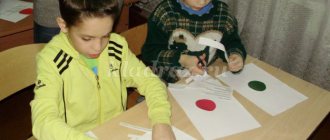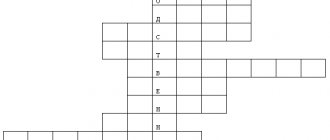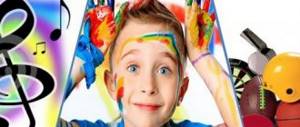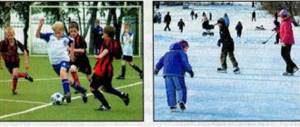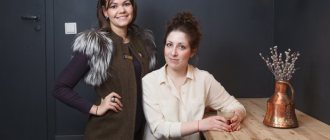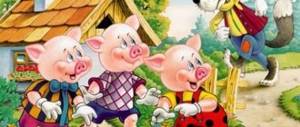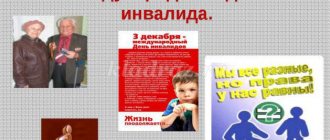Conversation “Good and bad deeds” lesson plan (middle group) on the topic
Conversation “Good and bad deeds”
Target:
- Form clear ideas about good and bad actions.
- Cultivate positive character traits: kindness, patience, politeness.
Tasks:
- Reveal children's ideas about good and bad deeds.
- Teach them to analyze their actions and evaluate them.
- Cultivate a sense of responsibility for one’s actions and respect for each other.
- Develop children's vocabulary.
Progress of the lesson:
Main part
Educator:
- Today we will talk about good and bad deeds. People live next to each other, communicate, and do different things. Sometimes people who are beautiful in appearance commit indecent acts, behave rudely and unethically. Such people are no joy to anyone! And, on the contrary, there are not very beautiful, but kind and honest people. And we want to be friends with them, to be like them. A cultured person will never be capricious or scream! There are many rules of behavior that people must follow.
Educator:
- Tell me guys, what good deeds are you doing? —What feelings did you experience when you did a good deed? -Has it ever happened that you did something bad? - Do you think you and I should try more to do good or bad deeds? - Why do you think so? - Of course, we must do only good deeds. Because kind, good deeds ennoble people. The world is becoming richer, kinder and better. You and I must distinguish good from bad.
Guys, you are a little tired and I suggest you get some rest. (Children stand in a circle)
Game: “I like you because...”
Educator:
- Children! Hold hands, look into the eyes of your friend, smile at him! Today I like you for your friendship. Look at your neighbor on the right. Remember his best sides and tell him, looking into his eyes: “I like you because...”
If you shared your candy with a friend - You did well, Everyone will say it. You found out someone else's secret And spread it right away, That's bad, no worse, That's even mean! , like a wild animal, You immediately jump into a fight, Believe me, you are not worthy to be called a Human! If you warmed up a cat, You feed the birds in the cold, It’s just beautiful, That’s the only way it’s needed! You blackened the dog’s eye, Threw the cat into a puddle. Rest assured - you are forty times worse than dogs. Respect the people around you, the elders, the younger ones too, and then you, my friend, will be called good. If you are among the guys, alone as at sea, only you are to blame for this bitter grief.
Proverb: “Good deeds are always praised”
.
Drawing on the topic: “My friend”
Educator:
- You each have a friend. What is your friend? What actions does he perform more often? Let's draw a portrait of a friend using our fingers.
— The portraits turned out wonderful! Well done! Once they are dry we will place them on our creative palette.
Final part
Educator:
- What did we talk about today? (Children's answers: about good and bad deeds) -What more actions should we try to do? Why? (Children’s answers: we should do more good deeds so that we don’t feel ashamed)
—What actions do well-mannered people do?
—What actions are more pleasant to do?
-Which person is more pleasant to be friends with?
— What was your mood at the end of the lesson?
Class hour “Good and bad deeds”
Class hour “Good and bad deeds”
Target:
Discuss with children the concepts of “bad” and “good” actions, consolidate knowledge about their own and other people’s things.
Tasks.
Educational:
reinforce positive and negative actions with children, as well as analyze them;
correctly assess your own behavior and the behavior of others;
create a desire to do good deeds.
Developmental:
develop the ability to analyze the actions of characters from the material read, communication skills, and cognitive interest.
Continue to develop the child’s understanding of various personality traits
Educating
:
cultivate a friendly, tolerant attitude towards each other;
teach how to use honesty in everyday life;
develop a negative attitude towards bad deeds.
Materials and manuals
: Presentation of didactic material on good and bad deeds, the book “What is good, what is bad” by V. Mayakovsky, an excerpt from the story by L.T. Tolstoy “Bone”, task cards.
Move
Introductory part.
- Children, let's all smile at each other. It seems to me that our group has become lighter. May this bright, joyful mood remain with us forever. Children sit on chairs. Emoticons came to visit us.
2. Main part.
Children, what do you think we will talk about now? (Children's answers)
The teacher invites the children to look at various pictures (slides) and determine where the good deeds are and where the bad ones are. (Presentation show)
Taking turns, showing slides, the children and the teacher discuss why this or that picture is considered a good or bad deed.
1. The boy helps his grandmother cross the road, is this good or bad? That's right, well done, this is very good.
2. The girl took the children’s toys, is that good or bad? Right is bad, but what do you think should be done in such a situation? Of course, offer to play together, but what else needs to be done?
3. The boy shoots birds, is that good or bad? That's right, very bad.
4. The boy reads a book to his little brother. This is very good.
5. Picking flowers is very bad.
6. Children play with matches. Is it good or bad?
7. Help mom. A very good deed!
8. Is it good to play sports? That's right, very good
9. Is it possible to offend children? This is very bad.
Well done guys, you did a very good job!
Physical education minute:
And now you and I will have a little rest and play.
Game "Monkeys".
The word game “Good and Bad” is being played.
Educator: - Guys, now prepare the colored circles. I will read excerpts from literary works familiar to you, and you will determine whether the heroes act well or badly. If you think it is good, then show a yellow circle, if it is bad, show a blue one.
Social and moral education of children Conversation Good and bad deeds
Social and moral education of children.
Conversation “ Good and bad deeds .”
Target:
Clarify, generalize and expand children's knowledge about good and bad deeds.
Instill in children the desire to do only good deeds.
Foster a culture of communication, friendly relationships, the desire to support friends, family and loved ones, and take care of them.
Learn to independently evaluate the actions of other people.
Educator: Guys, I suggest you listen to the poem:
WHERE WAS “THANK YOU”? Overnight, snowdrifts grew in the park, in the yard, in the garden. I'm barely making my way along the street. And I look to the left, And I look to the right: - Who's shoveling the snow there? — I’ll ask myself. This is my neighbor’s grandmother. We need to help grandma! I take the shovel from her, I’m always willing to help! I cleaned everything up! My face is burning from work. The old lady smiled at me and “Thank you!” says. I’m pleased to hear this, After all, I’m pretty tired... So it turned out that “thank you” I dug up under the snow!
R. Timershin
Educator: Why did the boy say that he dug “thank you” under the snow?
(children's answers)
Educator: What proverb can you tell this boy?
(children's answers)
Educator: Do you think it is difficult to earn the word “thank you” from an adult?
(children's answers)
Educator: What can adults say “thank you” to you for?
(children's answers)
Educator: What kind of actions are there? Are they always only good?
(children's answers)
Educator: Give examples of good deeds.
(children's answers)
Educator: And now the bad ones.
(children's answers)
Didactic game “Good-bad”.
(The teacher shows the children a plot picture; if there is a good deed on it, then you need to clap your hands; if it is bad, we don’t clap. The one who made a mistake comments on his decision).
Educator: Listen to Vladimir Mayakovsky’s poem “What is good and what is bad.”
WHAT IS GOOD AND WHAT IS BAD?
- If the wind tears the roofs, if there is hail, everyone knows that this is bad for walking. The rain came and went. The sun in the whole world. This is very good for both adults and children. If the son is blacker than night, dirt lies on his face, it is clear that this is very bad for the child’s skin. If a boy likes soap and tooth powder, that boy is very sweet and does well. If a crappy fighter beats a weak boy, I don’t even want to put that in a book. This one is shouting: “Don’t touch those who are smaller!” This boy is so good, he’s a sight to behold! If you tear a book and a ball in a row, the Octobrists say: you’re a bad boy. If a boy loves work and points his finger at a book, they write about him here: he is a good boy. The little one ran away from the crow, groaning. This boy is just a coward. This is very bad. This one, although only an inch taller himself, argues with a formidable bird. Brave boy, well, he will be useful in life. This one got into the mud and is happy. that the shirt is dirty. They say about someone like this: he is bad, a slob. This one cleans his felt boots and washes his galoshes himself. Although it is small, it is quite good. Remember this every son. Any child knows: his son will grow up to be a pig, if the son is a pig. The boy went joyfully, and the little one decided: “I will do well, and I will not do bad.”
Educator: Guys, do you do good deeds?
(children's answers)
Educator: And the bad ones?
(children's answers)
Educator: Let's try to do only good deeds, and then the world will become a much kinder place! Do you agree with me?
(children's answers)
